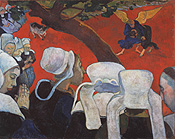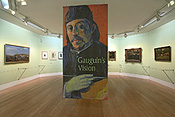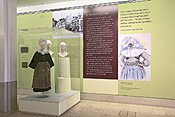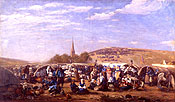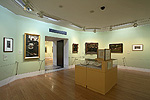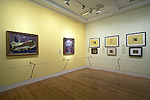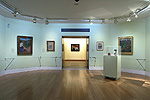The browser will either open the file, download it, or display a dialog.
|
Gauguin's Vision Gauguin's Vision |
|||||
| Gauguin's Vision, the splendid and superbly focused exhibition curated by Belinda Thomson at the Royal Scottish Academy, part of the National Galleries of Scotland complex in Edinburgh, this past summer (6 July-2 October 2005), centered on that artist's aesthetically audacious 1888 Vision of the Sermon, as this work in their permanent collection was called here (fig. 1). A thoughtful and thorough catalogue included everything one might ever have wanted to know about Paul Gauguin's powerfully inventive, but somewhat puzzling masterwork—and then some. The catalogue, of which Gauguin authority Belinda Thomson1 was the principal author—with contributions by Frances Fowle and Lesley Stevenson—is now the essential analysis. | ||||||
| In this admirable and exceedingly enjoyable exhibition, the myriad strands that came together in the formulation, development, and afterlife of this single important canvas, were teased out, chased down, and elucidated (fig. 2). It was the very model of a modern major exhibition: visually fresh and directed, it combined all manner of appropriate, and sometimes surprising works, while, with some one hundred items, not being overwhelmingly large. This was an "art in context" exhibition at its best, much in the vein of the lamentably now defunct, and sorely missed, "art in context" monographic publications that featured an important painting and constructed its aesthetic, historical, and cultural surrounds and theoretical underpinnings to wonderful result.2 Part of the real pleasure of the exhibition came from its focus. Thomson analyzed the quick gestation of the painting and, as stated in the catalogue, the "ideas, circumstances, pressures, and individuals" that were midwife to its appearance. In short, how it came to be. With the care, balance, thoroughness, nimble probing, and full scholarly apparatus that marked the exhibition and catalogue throughout—and yet without ponderousness or polemic—she also considered Gauguin's place and categorization within modernizing movements. | ||||||
| Thomson demonstrated her nuanced command of the complex subject, modifying and meticulously rectifying known information, citing and clarifying past arguments, and providing expanses and nuggets of new information beginning with the title of the work. Heretofore usually called "Vision After the Sermon" (Vision après le sermon), as it was familiar to many of us, occasionally with the additional "Jacob Wrestling with the Angel," this name was traced to an 1891 Paris sale catalogue. Yet in 1888, the year it was painted, Gauguin wrote it was to be called "Vision du Sermon" (Vision of the Sermon), when it was exhibited in Brussels for Les Vingt, the title to which it reverts here. | ||||||
|
Brittany and Iconography By the 1880s, interest in Brittany, the setting for Gauguin's canvas, was high and Pont-Aven was already an internationally known enclave for artists (and sightseeing city folk). Thomson suggests that Gauguin's literary interests may have led him to read Pierre Loti's well-known novel, Mon frère Yves of 1883, set in Brittany, which may have helped spark his curiosity about the region. Establishing the regional particularities of Brittany, with its special native costumes and customs, terrain and religiosity, is fundamental to an understanding of the iconography of Gauguin's painting, and was the exhibition's first order of business. Near the entrance was a display of Breton women's homespun costumes with their characteristic stiffly starched white headdresses, or coiffes (fig. 3). Each headdress design, explicated in terms of how it identified the wearer, indicated locale and status: small headgear was worn by working class women; a widow let the flaps of her headdress hang loose; sous-coiffes were for working; and special, ceremonial coiffes were designated for holidays. Among the benefits of Thomson having sojourned in Pont-Aven and immersed herself in its culture in preparation for the exhibition, were her careful combing of regional museums and observations made sur place: having noted the unusual amber red haze of the fields at harvest time, for example, as recorded in a large photograph, she suggests that the vibrant hue of the grains might well have triggered Gauguin's further intensified vermilion ground, tilted up to serve also as a background in his painting. |
|||||
| In the exhibition proper, each element of Gauguin's Vision of the Sermon was set forth among earlier and contemporary works, to be analyzed and compared, a gauge to understanding just what it was that Gauguin brought to his canvas. Its central motifs, the appearance and piety of the traditionally costumed Breton women, the theme of wrestling figures, the religious vision, the tree branch that bisects the composition, were also presented in other depictions of both fine and folk art. There were both familiar and virtually unknown works in that rare combination of maintaining high aesthetic standards while furthering the art historical story, the unpacking of how a painting might come to be. One such example was an early Boudin painting—so unlike his later beach scenes—the beautiful, crisp The Pardon of Sainte-Anne La Palud, 1858 (Musée Malraux, Le Havre, fig. 4), a scene of religious pilgrims come to the region for the "Pardons"—the Breton religious festivals of "forgiveness" that mingled Christian liturgical with remnants of Celtic elements and were characterized by processionals linked to specific sites and days. These pious figures were also a subject for Alphonse Legros and more than one painting by Pascal Dagnan-Bouveret, including his excellent 1888 The Pardon, Brittany, of the same year as Gauguin's Vision. It was immensely satisfying to see Dagnan-Bouveret's vertical version (Montreal Museum of Fine Arts, fig. 5), a slyly composed fragment that allows us to glimpse intriguing segments of faces among the rows of somber, darkly-dressed, white coiffed women (and a man) with hands quietly folded: the nose and lips of a young parishioner here, and an eye spied there in the back with piously lowered lid. Gauguin was thus shown to be far from alone in his attraction to Breton religiosity, customs, and apparel as a subject for his images—and it is against the work of other artists that his own idiosyncratic imagery is to be measured. The wrestling motif was examined by way of the ancient Breton tradition of the gouren, a local wrestling competition that in the nineteenth century drew the attention of tourists. These contests were the source for such popular prints as Hippolyte Lalaisse's "Wrestling at Rosporden," 1865, and Adolphe Leleux's "Wrestlers in Lower Brittany," 1864 (both Musée National des Arts et Traditions Populaires, Paris), with the combatants surrounded by rows of onlookers as well as Paul Sérusier's Wrestlers of ca. 1893 (Musée d'Orsay, Paris, fig.6). The inclusion of a cow that has baffled this viewer (for this is not Normandy, where the famous milk and butter would have justified a bovine presence as in Puvis de Chavannes's La Normandie) was here explained as the heifer or goat that was customarily tethered while waiting to be awarded to the victor of the contest.3 Other possible sources for the wrestling figures such as Japanese woodblock prints have been heretofore evoked, notably Hokusai's "Wrestlers" from The Manga. For my part, I would note that Puvis de Chavannes featured children wrestling at the center of his mural-sized Doux Pays, 1882 (Musée Bonnat, Bayonne), itself probably derived from a late antique prototype; and because Gauguin was a great Puvis admirer, that motif might well have been his compositional source for Breton Boys Wrestling (Private Collection, London), which it so resembles. | ||||||
| Although the motif of wrestling was contextualized as a regional tradition, it was also reexamined as a revitalized religious theme of biblical proportions, as in Delacroix's Jacob Wrestling with the Angel (represented by a study for his grand ca. 1850 mural), and other examples of that narrative by Gustave Doré in 1866, and Gustave Moreau, a watercolor of ca. 1878, as well as later versions by Paul-Emile Colin in 1896 and Odilon Redon in ca. 1910. That the vision of an angel might have been based on a person dressed like an angel who participated in the ceremonial events accompanying the Pardon, a theory put forward by one art historian, may not have been convincing to Thomson, for there was no specific mention of it.4 | ||||||
| In an 1888 letter to Vincent van Gogh, Gauguin explained that "the landscape and the wrestling. . . exist only in the imagination of the praying people as a result of the sermon."5 That is, the angel and Jacob, separated from the rest of the composition by the diagonal of the tree trunk, would be like an idea bubble in twentieth century cartoons. This however does not necessarily foreclose the possibility that their "vision"—apparently a shared, collective one—is not simply a phantasm of fervent religious devotees, but might have been instigated and prompted by an actual event, a reenactment of the pertinent biblical passage during the mystery plays, in the medieval tradition, performed especially near a church or cathedral on saints' days at the time. This is one of the tantalizing iconographic theories bandied about some years ago that seem not to have been discussed.6 | ||||||
| The depiction of a vision, from Gustave Moreau through Gauguin, received attention and broaches a much larger subject. Given the two different levels of the painting, as Thomson puts it, the praying figures and the "vision," the question is how Gauguin and other nineteenth-century artists introduced two disjunctive orders of reality in their work. Depictions of Joan of Arc's visions might have been explored, but Thomson, more properly focused, did not go off on this tangent. This is a topic I address elsewhere in the context of Puvis de Chavannes and one that merits extended analyses, especially since visual arts, by their nature, must render imaginings, visions, and dreams concrete.7 The devices or conventions used to signal such disjunctions—the introduction, for example, of paintings within paintings, that is the interjection of one image into another that nonetheless maintains their disparate actualities—are fascinating. In Gauguin's portraits, for example, Self-portrait: Les Misérables, 1888 (Van Gogh Museum, Amsterdam) the same year as his Vision, Emile Bernard is an imagined presence by way of his portrait tacked to the wall. But one thinks also of Gauguin's La Belle Angèle of 1889, in which Marie-Angélique Satre occupies an otherwise unexplained roundel (similar to a device in Japanese prints as Theo Van Gogh pointed out to his brother Vincent).8 Sculptors generally more comfortably combined two levels of reality in the nineteenth century when they introduced real along with allegorical figures. | ||||||
|
The thorny theme of religious painting in the later nineteenth century, an era of growing secularism, scepticism anti-clericalism and science, was explored in relation to Gauguin's own religious leanings. Inventive contemporary paintings on religious themes, such as Puvis de Chavannes's Saint Geneviève as a Child in Prayer (the preliminary version from the Van Gogh Museum, Amsterdam for the definitive 1876-7 mural at the Panthéon, then the Church of Sainte-Geneviève) were included, though not always reproduced in the catalogue. Gauguin was to be demonstrably beholden to Puvis's pictorial simplifications and compositions; in Puvis's composition onlookers gaze wonderingly at the pious girl much as Gauguin has the viewer witness the praying peasants in his Vision. Both artists thus skirt references to institutionalized religion while painting religious images. In "The Legacy of Vision of the Sermon," Thomson addresses the aesthetic aftermath in Gauguin's own work of religious themes, and what she characterized as the "susceptible `primitive'"—an original subset that involves the artist / subject interrelationship. She indicated a hierarchical, if not colonial, mindset of the "putative European spectator" (the artist), and thus ingeniously connected the Vision to such works as Manao tupapau or Spirit of the Dead Watching, equating the young girl to the praying Breton women as the "susceptible 'primitive'" (fig. 7). | |||||
| Extant drawings indicate no tonsured monk-like male on the right side of the painting, and therefore the figure that Thomson suggests might be a self-portrait would seem to be a late addition to the painting, and could possibly be a religious alter ego. As such this figure would be an addition to the roster of Gauguin's encrypted or half-hidden auto-portraits, a series of vivid roles in which he was ready to imagine himself, sometimes disguised, in his paintings. | ||||||
| In letters Gauguin described his Vision of the Sermon as a "religious" or "church painting" which he meant to give to the church of Pont-Aven, which however did not accept it. Amédée Guérard's painting of a modest interior hung with popular broadsides, Farm Interior or Sick Child of 1870 (Musée départmental breton, Quimper), documents how such images were displayed.9 That these simple, flat prints were so directly appreciated may have impelled Gauguin to want to emulate such rustic images to provide the kind of work that would appeal to the very peasants he painted. | ||||||
| Dividing the composition into two sections, and separating the "real" figures from those of the "vision" is a wide brown diagonal swath, a tree trunk with leafy small twigs. Given the tilted ground, this observer always perceives it as curiously like a muddy river—could it refer to the river Jabbok, mentioned in the bible, given Gauguin's love for double entendre images that Thomson mentions? Yet its overlap of the cow's head makes this improbable; the water barely indicated along the top border presumably indicates the river as Herban contends. Perhaps it is both a river and a tree, that is, a deliberately ambiguous image.10 The offbeat sources for its unusual configuration, Thomson convincingly contends, seem to be the tree trunk veering diagonally off to one side in Arthur Wesley Dow's Old Orchard of 1886 (Beard and Weil Art Galleries) and the startlingly similar trunk in Hiroshige's print, Plum Estate, Kameido (reversed), after which Van Gogh executed a painted version, an image that Gauguin may have known directly or through the latter. | ||||||
| A Bold Style Gauguin's canvas was a breakthrough painting in his oeuvre. The stage for its examination in the context of the current exhibition was set by a visual review of both his earlier work and works by other vanguard painters in the heady artistic milieu in 1880s France. For its part, the catalogue, after an introduction, was devoted to "The Search for a Style: Gauguin and His Artistic Peers," (also an element of the exhibition), which situated Gauguin vis-à-vis Camille and Lucien Pissarro, for example, at the beginning of this aesthetic journey. |
||||||
|
A central aspect of the exhibition was how—in what ways and prompted by what factors—Gauguin's work evolved during these crucial years, moving from his own version of Impressionism during his first stay in Brittany in 1886 to the radical simplifications and crude boldness of his 1888 canvas. In 1886 Gauguin took enormous interest in his Breton surrounds as his detailed, all but ethnographic drawings of peasants and their outfits attest. He was most creative and plainspoken in his experiments with ceramics (a medium to which he was introduced by the ceramicist Ernest Chaplet), with his primitivizing impulses obvious in vessels both lumpy—the remarkable Jardinière with Breton Woman and Sheep of 1886-7 (Petit Palais, Paris)—and elegant (fig.8). In the interval between his two Brittany stays he produced somewhat tame and modulated, if sometimes quirky, quasi-impressionist paintings in Martinique. | |||||
| His images continued to evolve during Gauguin's second stay in Brittany beginning in January 1888. Then, within a few short months that summer, his art was radicalized, and he quite suddenly attained the strong, intense, and rude new style realized in the work under scrutiny.11 There was a shift in emphasis from the simply, if penetratingly, observed and depicted object to a vigorously conceptualized and striking, synthesizing style since associated with Post-Impressionism. Very different aesthetic sources contributed to the self-consciously new, forceful manner manifest in Vision of the Sermon. Innovative elements in the work of Degas, as proposed convincingly by the inclusion of Woman Adjusting her Hat, 1884 (Private Collection) with its strongly silhouetted figure against a flat red background, indicated a clear precedent for Gauguin's image, if not a possible source. | ||||||
| Gauguin's new preference for graphic simplifications, intense colors, and the increasingly crude, was explored on a number of fronts. The catalogue discussed his taste for caricature, as well as his interest in children's illustrations. Japonisme was another important component, directly and through Van Gogh's japoniste compositions; a selection of Japanese prints with flattened areas of saturated red made the point. Certainly, his own ceramics and knowledge of other pottery reinforced this direction, as did the crudely carved furniture on which he collaborated with Emile Bernard in Pont-Aven (heralding his South Seas carvings). Brittany itself contributed to his new, primitivizing style, for what particularly attracted Gauguin to the region, according to his own writing, was "le sauvage le primitif" (prefiguring the appeal of the South Seas). Cheap, religious Epinal prints (or Epinal-like woodcuts produced in Rennes) provided another paradigm for Gauguin's simply, but strongly outlined figurations and flat, unmodulated colors that he may have thought would appeal to the same modest buyers of those popular broadsides. | ||||||
| A most important and persistent question demonstrated in the exhibition was the impact of the then-twenty-year-old Emile Bernard's startlingly original, daringly abbreviated, and willfully crude configurations on Gauguin's work. That he was the primary catalyst for Gauguin's boldness was visually explicated by way of truly exciting pictorial samples, works that literally prepared the way for the latter's Vision of the Sermon. Bernard himself was much taken with Epinal prints, as was evident in the flat simplicity and stiff contour lines of his drawings and paintings on display. His Breton Women in the Meadow / Pardon at Pont-Aven of 1888 (Private Collection), cruder and more daring than Gauguin's Vision, has long been pointed to as key to the latter's changed trajectory. It was included in the exhibition, and although Bernard's 1887 Baigneuses à la vache rouge (Musée d'Orsay), included in the catalogue, was not, its crude, heavily outlined figures, saturated, flat colors and truncated bodies, and indeed the red cow itself, might have provided a prototype for Gauguin's cow. In the catalogue, Thomson writes that Bernard's "relative inexperience was compensated by a fearlessness, a rebellious spirit, a ready artistic curiosity, a gift for caricature, and an intelligence which allowed him to assimilate ideas quickly" (p.47 & 50). Gauguin's deft appropriations of his very original pictorial ideas were to anger Bernard increasingly over the years, and his ever more fitful claims that he had gotten there first (of which I am convinced) and been robbed by Gauguin, are detailed by Thomson. To this viewer, no other explanation—the many aesthetic strands that Thomson skillfully weaves together notwithstanding—can account for the radical change of Gauguin's own vision within a space of months. One need only compare Landscape from Brittany with Breton Women and Landscape from Pont-Aven, Brittany of 1888 (both Ny Carlsberg Glyptothek, Copenhagen) or Breton Girls Dancing, Pont-Aven of 1888 (National Gallery of Art, Washington, D. C.), with the Vision. | ||||||
| The impact and legacy of Vision of the Sermon comprised another section of the exhibition and catalogue. The establishment of Gauguin's new aesthetic and its spread to a new group of artists who called themselves the Nabis ("prophets") was the subject of the last gallery of the exhibition. Here was Sérusier's small but famous Le Bois d'Amour of 1888 (Musée d'Orsay), which has come to be known as The Talisman, the lucky charm of a new art. It was surrounded by other paintings in this new style, often with mystical, religious, theosophical imagery, such as in Paul Ranson's Christ and the Buddha and Maurice Denis's The Mystical Grape Harvest, both of ca. 1890 (both Triton Foundation, The Netherlands). The exhibition had a marvelous selection of work, and Thomson mustered remarkable finds, even to the witty and somewhat mischievous coda of Spencer Gore's Gauguins and Connoisseurs at the Stafford Gallery (1911, Private Collection) showing the Vision with two other of the most inventive Gauguin works of this period, Manao tupapau, (Spirit of the Dead Watching) and Christ in the Garden of Olives, displayed for the delectation of London's chic set to eye and ogle (fig. 7). This was the afterlife of a trio of Gauguin's more difficult masterworks as they entered the red-carpeted world of commerce and the marketplace. The choice selection of works themselves in these galleries told the story of Gauguin's legacy visually with no further textual or intellectual explanation or stretch of the imagination needed. | ||||||
| The Catalogue In the catalogue, Gauguin was at the outset situated in his aesthetic circumstances and ambitions: the artists he knew, admired, collected, or compared himself to by the 1880s—(not yet to their disadvantage as his competitive strain would later notoriously prompt)—Pissarro, Cézanne (he had six paintings by him), Degas, Monet—and the theories of the time. Thomson introduced data about Gauguin's study of the old masters and his admiration for Delacroix. Her well-informed speculations are also of interest: how galled Gauguin must have become during his protracted stay with his wife's family in Copenhagen not long after he had decided to give up a career in banking for painting, at the artistic success of his Norwegian brother-in-law, Fritz Thaulow. Thomson meticulously cites sources, written and verbal, in a rare and much to be admired fashion. |
||||||
| The catalogue took up many of the themes communicated visually in the exhibition. Gauguin's new style was analyzed by way of its formal elements: noting that his colors, most conspicuously red, were intensified; the extent to which this may have originated in the appearance of the fields themselves; Degas's work; and Japanese or Epinal prints. Similarly, the outlined, flattened forms, apparent qua shapes that characterize the painting, and precedents in cloisonniste work and prints were discussed. (Here again from my own Puvis-centric point of view I think Puvis's mural technique could have been invoked). Each of these issues received careful examination. | ||||||
| Contributions by Frances Fowle and Lesley Stevenson completed the catalogue analyses. In "Following the Vision: From Brittany to Edinburgh," Fowle discusses the afterlife of the painting, its peregrinations and provenance from Pont-Aven to Scotland. In what is both an essay on the history of taste and the adventurous collecting of such avant-garde painting in comparison to more immediately acceptable works, Fowle provides perceptive short sketches of those perceptive, prescient, or adventurous collectors like Michael Sadler through whose hands the work passed as it made its way to the National Galleries of Scotland. | ||||||
| Lesley Stevenson wrote on Gauguin's materials and technique in Vision of the Sermon. Such technical analyses by gifted conservators who report not only on the physical components of a work, but also place these materials—support, medium, layerings—within a historical context, play an increasing part in the best studies. As materials and technique have everything to do with the formulation, development, and appearance of a work, as well as an artist's temperament and intentions, and as technology is increasingly sophisticated, it is a timely advance. For instance, the author suggests here that Gauguin, having introduced a thin layer of wax to the painted surface because of his predilection for smooth, opaque, and non-reflective surfaces, ironed some of his works. (This is in counter-distinction to someone like Puvis de Chavannes, who mixed wax into his medium to achieve a matte-like effect in his mature murals, but maintained a scumbled surface). | ||||||
| The care taken throughout the production of the exhibition and catalogue extended to indicating with an asterisk which of the comparative images reproduced in the catalogue was included in the exhibition, thus preventing the confusion often ensuing from the now routine practice of having wide-ranging scholarly essays with reproductions not confined to the works on hand. On the other hand, unfortunately not all the items exhibited were reproduced (some thirty-one were omitted, presumably because of budgetary constraints). The exhibition checklist, arranged by the hang of the exhibition, made searches for specific works somewhat cumbersome given that there was no index. | ||||||
| This review cannot adequately list, let alone comment on, the various and far-ranging themes Thomson and her colleagues explore, the known information they nudge and further penetrate, the scads of new material they present. The exhibition and its catalogue serve as a model art historical venture asserting that a given, preferably superb work, is an intricacy that needs imaginative, shrewd, unrelenting, sometimes stubborn, and of course sage, parsing. | ||||||
|
Aimée Brown Price |
||||||
|
1. Belinda Thomson also authored Gauguin, (London: Thames and Hudson, 1987). 2, These included among others, Hugh Thomas, Goya: The Third of May 1808; John Gage, Turner: Rain, Steam and Speed; Theodore Reff, Manet:Olympia; Joel Isaacson, Monet: Le Déjeuner sur l'herbe; and Marilyn Lavin, Piero della Francesca: The Flagellation; all published in 1972 by Penguin, London, and Viking, New York. 3. The thesis proposed by Mathew Herban III in "The Origin of Paul Gauguin's Vision After the Sermon: Jacob Wrestling with the Angel (1888)," in the Art Bulletin, 59 (September 1977), 415-420, that the cow is associated with sacrifices made since pagan times, the vestiges of which then still existed in the form of carved statuettes of cows, is not visited; Herban's source was a description of local customs in the Guide bleu (n.d.). 4. Ibid, 419-420. This work is, however, cited in the bibliography 5. As Dario Gamboni has pointed out in his "Gauguin's Genesis of a Picture," in Nineteenth-Century Art Worldwide (Autumn, 2003), 7-8 of printed copy. "Pour moi dans ce tableau le paysage et la lutte n'existent que dans l'imagination des gens en prière par suite du sermon." Gamboni cites Victor Merlhes, ed. Correspondance de Paul Gauguin, (Paris, 1984), p. 232, no. 165. 6. See Herban (1977), 415. My thanks to Karen Pope for transmitting this citation for an only half-remembered (by me) discussion. Herban may or may have been the same commentator (whom I remember as a woman) who discussed the possible origins of the vision in a mystery play. I have been unable, however, to track down this paper, presented at the College Art Association some years ago as I recall. 7. See Aimée Brown Price, Pierre Puvis de Chavannes: Vol. 1, A Critical Study of His Life and Art, and vol. 2, A Catalogue Raisonné of the Painted Work (London and New Haven: Yale University Press, forthcoming 2007). 8. See Françoise Cachin, Gauguin, The Quest for Paradise, [trans. from French, Gallimard Edition, 1989] (New York: Discoveries and Harry N. Abrams, Inc., 1992), 61. 9. See Victor Merlhès (ed.), Correspondance de Paul Gauguin, Letter to Vincent van Gogh, ca. 25-7 September 1888, (Paris: Fondation Singer-Polignac, 1984), vol. 1 (1873-88), 230-2. 10. As suggested by Janet Whitmore in a note to this author. 11. The importance of that summer in Gauguin's art has been emphasized at least since H. R. Rookmaaker's 1972 study, Gauguin and 19th Century Art Theory, (Amsterdam: Swets & Zeitlinger, 1972), itself based on a 1959 doctoral dissertation. |


